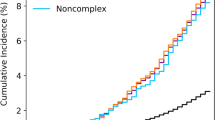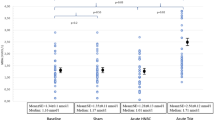Abstract
Study design
Cross-sectional study.
Objectives
The purposes of this study were to assess (i) prevalence of self-reported multiple chronic conditions (MCC) in a population-based cohort of persons with traumatic spinal cord injury (TSCI) and (ii) the association between health-related behaviors and MCC.
Setting
Population-based TSCI cohort.
Methods
Participants included 716 adults with TSCI of at least 1-year duration who were identified through a population-based TSCI surveillance system. Standard questions from the Behavioral Risk Factor Surveillance System measured cigarette smoking, binge drinking, planned exercises, and 10 chronic health conditions (CHC), including diabetes, heart attack, angina (or coronary artery disease), stroke, cancer, asthma, kidney disease, arthritis, depressive disorder, chronic obstructive pulmonary disease. MCC was defined as having two or more CHCs in this study. Multivariate logistic regression models were used to assess the association between health-related behaviors and MCC.
Results
Almost half (45%) of the study sample had MCC. After controlling for demographic and injury characteristics, participants with smoking history of at least 100 cigarettes were 59% more likely to develop MCC, and those who had planned exercises at least three times a week were 36% less likely to have MCC.
Conclusions
We found MCC prevalence was high among people with TSCI, and MCC was associated with cigarette smoking and planned exercise.
Similar content being viewed by others
Log in or create a free account to read this content
Gain free access to this article, as well as selected content from this journal and more on nature.com
or
References
Center for Medicare and Medicaid Services. Chronic conditions among medicare beneficiaries, Chartbook. 2012 ed. Baltimore, MD: Center for Medicare and Medicaid Services; 2012.
National Quality Forum. Multiple chronic conditions (MCC) measurement framework; 2012. http://www.qualityforum.org/Projects/Multiple_Chronic_Conditions_Measurement_Framework.aspx.
Charlifue SW, Weitzenkamp DA, Whiteneck GG. Longitudinal outcomes in spinal cord injury: aging, secondary conditions, and well-being. Arch Phys Med Rehabil. 1999;80:1429–34.
Garshick E, Kelley A, Cohen SA, Garrison A, Tun CG, Gagnon D, et al. A prospective assessment of mortality in chronic spinal cord injury. Spinal Cord. 2005;43:408–16.
Krause JS, Carter RE, Pickelsimer E, Wilson D. A prospective study of health and risk of mortality after spinal cord injury. Arch Phys Med Rehabil. 2008;89:1482–91.
Saunders LL, Clarke A, Tate DG, Forchheimer M, Krause JS. Lifetime prevalence of chronic health conditions among persons with spinal cord injury. Arch Phys Med Rehabil. 2015;96:673–9.
Wingard DL, Berkman LF, Brand RJ. A multivariate analysis of health-related practices: a nine-year mortality follow-up of the Alameda County Study. Am J Epidemiol. 1982;116:765–75.
Steinberg MB, Schmelzer AC, Lin PN, Garcia G. Smoking as a chronic disease. Curr Cardio Risk Rep. 2010;4:413.
Buttar HS, Li T, Ravi N. Prevention of cardiovascular diseases: role of exercise, dietary interventions, obesity and smoking cessation. Exp Clin Cardiol. 2005;10:229–49.
Shield KD, Parry C, Rehm J. Chronic diseases and conditions related to alcohol use. Alcohol Use: Curr Rev. 2014;35:155–71.
Price C, Makintubee S, Herndon W, Istre GR. Epidemiology of traumatic spinal cord injury and acute hospitalization and rehabilitation charges for spinal cord injuries in Oklahoma, 1988–1990. Am J Epidemiol. 1994;139:37–47.
Krause JS, Coker J, Charlifue S, Whiteneck GG. Health behaviors among American Indians with spinal cord injury: comparison with data from the 1996 Behavioral Risk Factor Surveillance System. Arch Phys Med Rehabil. 1999;80:1435–40.
Saunders LL, Ekoja E, Whitlock CS, Dipiro ND, Gregory-Bass R, Krause JS. A comparison of health behaviors between African Americans with spinal cord injury and those in the general population. NeuroRehabilitation. 2013;33:449–56.
Saunders LL, Krause JS, Saladin M, Carpenter MJ. Prevalence of cigarette smoking and attempts to quit in a population-based cohort with spinal cord injury. Spinal Cord. 2015;53:641–55.
Davis JF, Cao Y, Krause JS. Changes in alcohol use after the onset of spinal cord injury. J Spinal Cord Med. 2018;41:230–7.
van den Berg-Emons RJ, Bussmann JB, Stam HJ. Accelerometry-based activity spectrum in persons with chronic physical conditions. Arch Phys Med Rehabil. 2010;91:1856–61.
Blair SN, Brodney S. Effects of physical inactivity and obesity on morbidity and mortality: current evidence and research issues. Med Sci Sports Exerc. 1999;31(11 Suppl):S646–62.
Rajan S, McNeely MJ, Warms C, Goldstein B. Clinical assessment and management of obesity in individuals with spinal cord injury: a review. J Spinal Cord Med. 2008;31:361–72.
CDC. Behavioral risk factor surveillance system; 2010. http://www.cdc.gov/brfss/questionnaires/pdf-ques/2010brfss.pdf.
Ward BW, Schiller JS, Goodman RA. Multiple chronic conditions among US adults: a 2012 update. Prev Chronic Dis. 2014;11:E62.
Bernell S, Howard SW. Use your words carefully: What is a chronic disease? Front Public Health. 2016;4:159.
Albert PR. Why is depression more prevalent in women? J Psychiatr Neurosci. 2015;40:219–21.
Srikanth VK, Fryer JL, Zhai G, Winzenberg TM, Hosmer D, Jones G. A meta-analysis of sex differences prevalence, incidence and severity of osteoarthritis. Osteoarthr Cartil/Osteoarthr Res Soc. 2005;13:769–81.
van Vollenhoven RF. Sex differences in rheumatoid arthritis: more than meets the eye. BMC Med. 2009;7:12.
Acknowledgements
The contents of this publication were developed under a grant from the National Institute on Disability, Independent Living, and Rehabilitation Research (NIDILRR grant number 90IF0070). NIDILRR is a Center within the Administration for Community Living (ACL), Department of Health and Human Services (HHS). The contents of this publication do not necessarily represent the policy of NIDILRR, ACL, HHS, and you should not assume endorsement by the Federal Government.
Author contributions
YC was responsible for introduction, research method, and result sections. MJ was responsible for literature search and review. JK was responsible for discussion and conclusion sections.
Author information
Authors and Affiliations
Corresponding author
Ethics declarations
Statement of ethics
We certify that all applicable institutional and governmental regulations concerning the ethical use of human volunteers were followed during the course of this research.
Conflict of interest
The authors declare that they have no conflict of interest.
Rights and permissions
About this article
Cite this article
Cao, Y., Jarnecke, M. & Krause, J.S. Health-related behaviors and multiple chronic health conditions among persons with traumatic spinal cord injury. Spinal Cord 57, 367–371 (2019). https://doi.org/10.1038/s41393-018-0227-3
Received:
Revised:
Accepted:
Published:
Issue date:
DOI: https://doi.org/10.1038/s41393-018-0227-3



